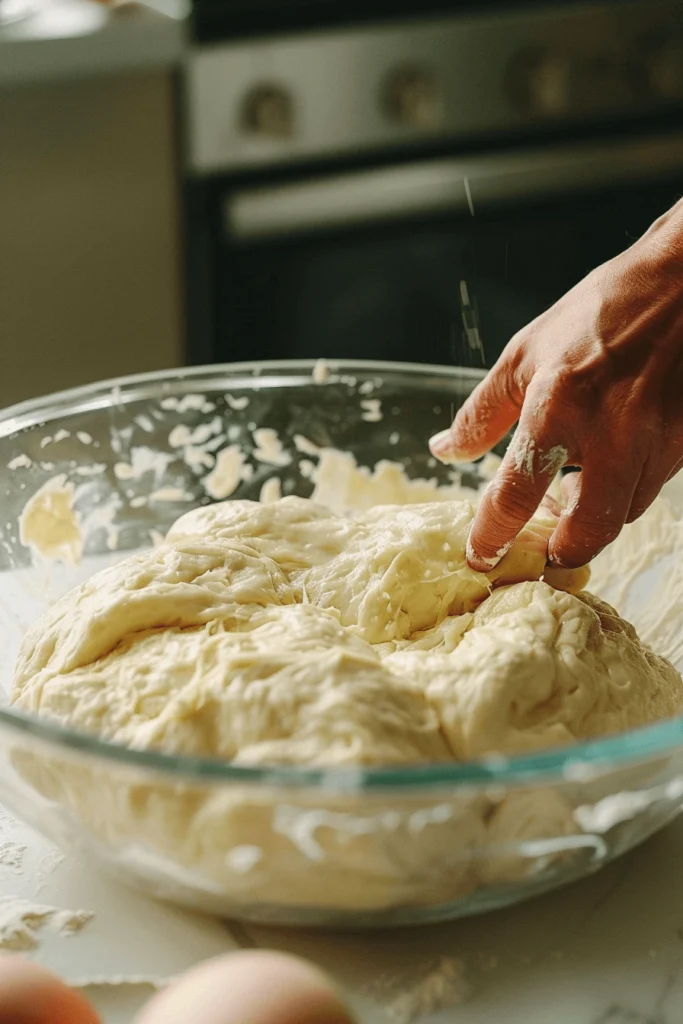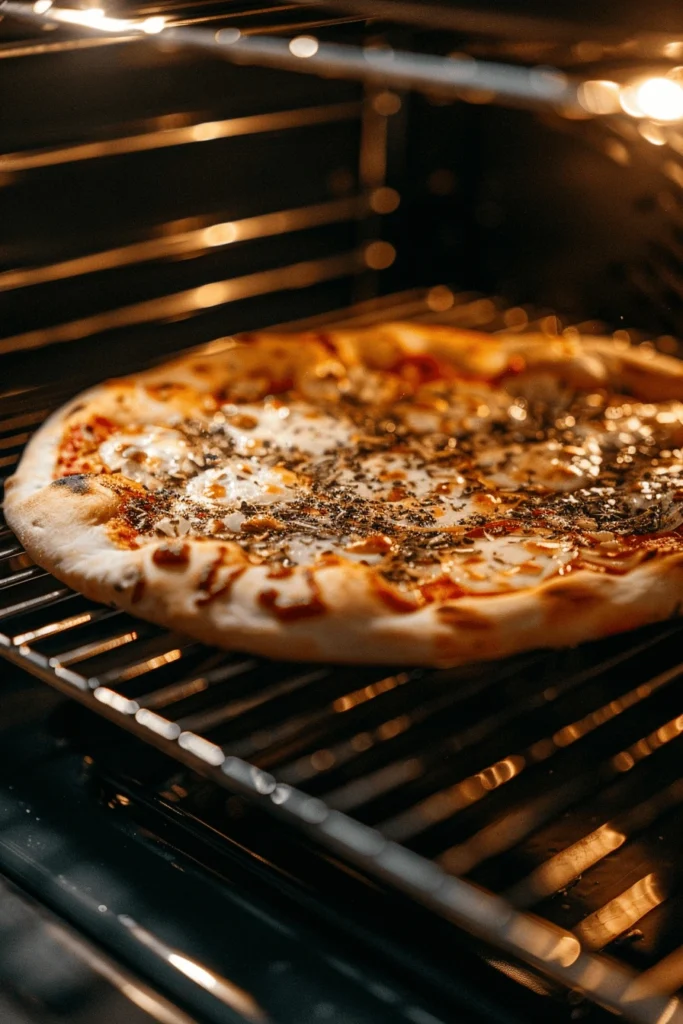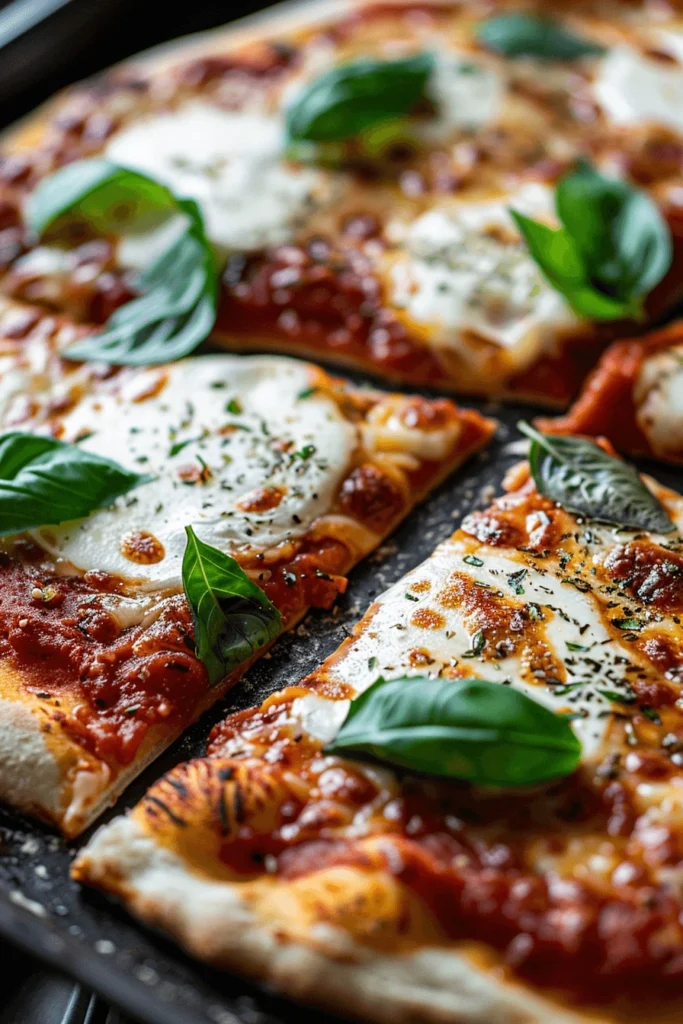If you’ve ever stared at a regular pizza and sighed like a Shakespearean hero denied true love, welcome to the club. A good pizza base gluten free can feel like chasing a mythical unicorn—delicious, fluffy, yet free from the dreaded gluten. But fear not, friend. This recipe journey will walk you through choosing the best flours, mastering the perfect dough texture, and creating a base so good your gluten-loving friends might just beg for seconds.
Print
Pizza Base Gluten Free
- Total Time: 40 minutes
Ingredients
2 cups gluten free flour blend
1 tsp salt
1 tbsp olive oil
1 cup warm water
1 tsp dry yeast
Instructions
Mix warm water, yeast, and olive oil in a bowl. Let it sit for 5 minutes to activate.
Add gluten free flour and salt, mixing until dough forms.
Knead lightly, then let rest for 30 minutes.
Pre-bake crust at 425°F for 8–10 minutes.
Add toppings and bake another 10–15 minutes until golden.
- Prep Time: 20 minutes
- Cook Time: 20 minutes
Nutrition
- Serving Size: 1 pizza base
Table of Contents
Understanding the Basics of a Pizza Base Gluten Free
What Does “Gluten Free” Really Mean?
Before we roll up our sleeves and start mixing, let’s break down the phrase pizza base gluten free. Gluten is a protein found in wheat, barley, and rye that gives traditional pizza dough its stretchy, chewy texture. Unfortunately, for people with celiac disease, gluten intolerance, or sensitivity, even a small amount can cause digestive trouble and inflammation. Going gluten free means using alternative flours and binders to mimic the same structure without that protein. The result? You can still enjoy a crisp, golden pizza base without feeling like you’ve swallowed a brick.
Gluten free pizza bases rely on starches and whole-grain flours such as rice flour, tapioca starch, sorghum flour, and cornmeal. Instead of the natural gluten network, these recipes often use xanthan gum or psyllium husk to bind the dough together and prevent it from falling apart. Without these adjustments, your “pizza” could turn into a soggy flatbread impersonator.
Why a Gluten Free Pizza Base is Different From Regular Dough
Traditional pizza dough benefits from gluten’s elasticity — you can knead it, stretch it, and toss it dramatically into the air (bonus points if you don’t hit the ceiling fan). Gluten free dough? Not so much. It’s more like a thick batter than a stretchy ball of dough, requiring gentle handling and sometimes a spoon or spatula instead of your hands.
The hydration level is also different. Gluten free doughs usually need more water or liquid because alternative flours absorb moisture differently. This higher hydration helps create a soft, airy center while still getting that crispy edge we all love. The baking method also changes slightly. Pre-baking the crust for a few minutes before adding toppings is a game-changer — it keeps the middle from being gummy while ensuring the edges crisp beautifully.
Looking for inspiration? Try Gluten Free Filo Sheets for another versatile dough option that works for savory and sweet creations.
Choosing the Best Gluten Free Flours for Pizza Base
Top Gluten Free Flour Options for Pizza Dough
The heart of a great pizza base gluten free is the flour blend. Unlike regular wheat flour, no single gluten free flour can give you the perfect chew, flavor, and structure. You need a team effort. Some of the best contenders include:
- Rice Flour – Light, neutral in flavor, and forms the bulk of many gluten free blends.
- Tapioca Starch – Adds chewiness and a slight stretch to the dough.
- Sorghum Flour – Nutty, wholesome flavor that balances the blandness of starches.
- Cornmeal – Gives a rustic texture and crispy bottom.
- Potato Starch – Helps retain moisture for a tender bite.
A balanced blend often contains 60–70% starches (rice, tapioca, potato) and 30–40% whole-grain flours (sorghum, buckwheat, millet) for both structure and flavor. This ratio helps you mimic the airy lift of traditional pizza without creating a cardboard-like crust.
Check out Gluten Free Carrot Cake Recipe for more inspiration on using rice and sorghum flours in baking.
How to Create a Perfect Gluten Free Flour Blend
If you’re making your own blend for pizza base gluten free, think of it like crafting a playlist — you want variety, balance, and just the right “beat.” Start with a base flour (like white rice or brown rice flour), add starches for structure, and a small amount of protein-rich flour (such as chickpea or amaranth) for extra bite.
Here’s a simple DIY Gluten Free Pizza Flour Blend:
| Ingredient | Amount | Purpose |
|---|---|---|
| White Rice Flour | 2 cups | Neutral base |
| Tapioca Starch | 1 cup | Stretch & chew |
| Sorghum Flour | 1 cup | Flavor & nutrition |
| Potato Starch | ½ cup | Moisture retention |
| Xanthan Gum | 1 tbsp | Binding agent |
Whisk thoroughly and store in an airtight container. This blend works beautifully for pizza crusts, flatbreads, and even focaccia-style bakes.
Essential Ingredients Beyond Flour
Binders: Xanthan Gum, Psyllium Husk, and More
When you make a pizza base gluten free, the real challenge is replacing gluten’s role as the structural hero. Gluten is what gives traditional dough its stretch and bounce, so without it, you need binders to hold everything together. A good binder makes sure your pizza base gluten free doesn’t fall apart when you pick up a slice.
Popular binder options include:
- Xanthan Gum – Gives elasticity and mimics gluten’s chewy feel.
- Psyllium Husk Powder – Locks in moisture and creates a soft yet sturdy bite.
- Guar Gum – A plant-based thickener that prevents dryness.
- Chia or Flaxseed Meal – Forms a natural gel when mixed with water, adding binding power.
Many bakers mix xanthan gum with psyllium husk for the perfect balance of structure and chew in a pizza base gluten free. Without a good binder, your crust risks becoming crumbly and dry.
Yeast, Salt, and Oil in Gluten Free Pizza Dough
While the binder keeps your pizza base gluten free together, yeast brings it to life. Yeast adds flavor, creates air pockets for a lighter crust, and delivers that classic pizzeria aroma. Salt strengthens the dough and enhances flavor, while olive oil keeps the crust tender and prevents it from drying out.
Here’s how they work together:
- Yeast – Use instant or active dry yeast for reliable rising.
- Salt – Balances flavor and improves dough stability.
- Olive Oil – Boosts flavor and keeps the pizza base gluten free soft.
When activating yeast, always use warm water (around 105°F–110°F). If the water is too hot, you’ll kill the yeast; too cold, and it won’t activate properly. That little foam at the top? That’s the sign your pizza base gluten free will rise just right.
Discover flavor inspiration in our Garlic Parmesan Chicken Meatloaf, where seasonings and oils make all the difference.
Step-by-Step Recipe for the Perfect Pizza Base Gluten Free
Measuring Ingredients Accurately for Consistent Results
For a pizza base gluten free that turns out perfectly every time, precision is everything. Gluten free flours behave differently from wheat flour, so a little too much or too little liquid can completely change your crust’s texture. The safest way to measure is by weight using a kitchen scale rather than cups.
Here’s the base recipe (makes one large or two medium pizzas):
| Ingredient | Amount | Notes |
|---|---|---|
| Gluten Free Flour Blend (from Part 2) | 3 cups (360g) | Pre-mixed for best results |
| Instant Yeast | 2 tsp (6g) | Activates in warm water |
| Warm Water (105°F–110°F) | 1½ cups (360ml) | Temperature is key |
| Olive Oil | 3 tbsp (45ml) | Adds flavor & moisture |
| Salt | 1 tsp (6g) | Enhances taste |
| Xanthan Gum | 1 tsp (4g) | Keeps the pizza base gluten free stable |
If your kitchen is humid, you may need slightly less water. In a dry climate, a splash more can help the pizza base gluten free hold together.
Looking for a crispy dough experience? Check out our Deep Fried Ravioli for golden perfection.
Mixing, Kneading, and Resting the Dough

- Activate the Yeast: Combine warm water, yeast, and a pinch of sugar. Let it foam for about 5 minutes.
- Combine Dry Ingredients: In a large bowl, whisk together the gluten free flour blend, xanthan gum, and salt.
- Add Wet Ingredients: Pour the activated yeast mixture and olive oil into the dry mix. Stir until a thick, sticky dough forms.
- Gentle Kneading: Unlike wheat dough, a pizza base gluten free doesn’t need heavy kneading. Simply fold the dough gently for 2–3 minutes until smooth.
- Rest: Cover with plastic wrap or a damp towel and let it sit in a warm spot for 30–45 minutes so the yeast can develop flavor and lightness.
Remember — a pizza base gluten free will be softer and wetter than traditional dough. That’s perfectly normal, and it’s part of what makes the crust tender yet crisp once baked.
Shaping and Pre-Baking for a Crispy Crust
Techniques for Shaping Gluten Free Dough Without Tearing
Shaping a pizza base gluten free is a different game from working with traditional dough. Instead of a stretchy ball that you can toss in the air, you’re dealing with a softer, stickier dough that needs gentle handling. The goal is to spread it evenly without tearing or overworking it.
Here’s how to do it right:
- Prepare Your Surface: Lightly oil your baking sheet or pizza stone. You can also line it with parchment paper to make transferring easier.
- Oil Your Hands: Instead of dusting with flour, lightly coat your hands with olive oil to prevent sticking and keep the pizza base gluten free moist.
- Press, Don’t Roll: Gently press the dough outward from the center with your fingertips, rotating the pan as you go. Avoid using a rolling pin — it can flatten the dough too much and make it dense.
- Aim for Even Thickness: Try to keep the center about ¼ inch thick and the edges slightly thicker to form a natural crust.
This gentle approach prevents cracks and helps create a base that bakes evenly.
Looking for more ways to handle delicate doughs? Don’t miss our Gluten Free Filo Sheets guide.
Why Pre-Baking is the Secret to Success
Pre-baking (also called par-baking) is a must for a pizza base gluten free. Without gluten, the dough takes longer to firm up in the oven, and adding wet toppings to raw dough can make the center soggy.
Here’s how to do it:
- Preheat the Oven: Set it to 425°F (220°C) for a hot, even bake.
- Bake the Plain Crust: Place the shaped dough in the oven for 7–10 minutes until the edges just start to firm up and the surface loses its raw look.
- Cool Slightly Before Topping: Let the crust sit for a few minutes before adding sauce and toppings. This helps lock in structure so your pizza base gluten free stays crisp under the weight of cheese and vegetables.
Once pre-baked, you can top your crust and return it to the oven for another 10–15 minutes until golden and bubbly.

Toppings and Baking Tips for Gluten Free Pizza
Pairing the Right Sauces and Cheeses
The right toppings can turn a good pizza base gluten free into an unforgettable one. Since gluten free crusts tend to have a lighter flavor, your sauce and cheese choices play a big role in creating balance.
Sauces to Try:
- Classic Tomato Sauce – Rich and tangy, it complements almost any topping.
- Garlic Cream Sauce – Perfect for chicken, spinach, or mushroom pizzas.
- Pesto – Adds a fresh, herby punch without being too heavy.
Cheeses That Shine:
- Mozzarella – Melts beautifully and gives that classic pizza pull.
- Provolone – Slightly sharper flavor for extra depth.
- Goat Cheese – Adds a tangy creaminess that pairs well with vegetables.
Looking for more inspiration? Check out our Garlic Parmesan Chicken Meatloaf to see how flavors can be layered for impact.

Baking Temperature and Time for Optimal Results
A pizza base gluten free needs a slightly different baking strategy than wheat-based dough. The goal is to crisp the outside without drying out the inside.
Baking Steps:
- Preheat Hot: Aim for 425°F–450°F (220°C–230°C) to get that instant crust set.
- Use a Pizza Stone or Steel: These retain heat and create a golden bottom crust.
- Watch the Time: After pre-baking (from Part 5), add toppings and bake for 10–15 minutes until the cheese bubbles and the edges turn golden.
For extra crispiness, you can switch to the broil setting for the last 1–2 minutes — just keep a close eye so nothing burns.
Troubleshooting Common Gluten Free Pizza Base Issues
Why Your Dough is Too Sticky or Too Dry
One of the most common frustrations when making a pizza base gluten free is getting the dough texture right.
- Too Sticky: This usually means there’s too much liquid. Measure carefully, and if needed, add 1–2 tablespoons of your gluten free flour blend at a time until it’s workable. Also, oiling your hands can help manage stickiness without adding excess flour.
- Too Dry: If the dough cracks or crumbles when shaping, it likely needs more moisture. Add warm water one tablespoon at a time until the dough comes together. Remember, a pizza base gluten free should be slightly wetter than wheat dough to bake up tender.
For more texture tips, take a look at our Gluten Free Carrot Cake Recipe — moisture balance is key in both baking worlds.
Dealing with a Dense or Crumbly Crust
A dense or crumbly pizza base gluten free can be disappointing, but it’s usually fixable.
- Lack of Rise: Check that your yeast is fresh and properly activated. Old yeast won’t give you that airy lift.
- Insufficient Binder: Without enough xanthan gum or psyllium husk, the dough won’t hold together well. Adjust binder amounts slightly for better texture.
- Overbaking: Too much oven time can dry out the crust, making it hard instead of chewy.
A quick trick to revive a slightly dry gluten free crust is to brush it lightly with olive oil before the final minutes of baking — it helps lock in moisture and adds a beautiful golden color.
Health Benefits and Nutritional Insights
Lower Gluten Intake for Better Digestion
Choosing a pizza base gluten free is more than just a trend — for many, it’s a necessity. People with celiac disease, gluten sensitivity, or wheat allergies can enjoy pizza without the uncomfortable bloating, cramps, or fatigue that gluten might cause. Even those without a diagnosed intolerance sometimes find that lowering gluten intake improves digestion and energy levels.
Unlike traditional dough, a pizza base gluten free can be made from rice flour, almond flour, or chickpea flour — all of which are naturally gluten free and easy on the stomach. These flours also add unique flavors and nutritional perks, making every bite both tasty and nourishing.
Nutrient Profile of Popular Gluten Free Flours
Different flours used for pizza base gluten free each bring their own nutrient benefits.
| Flour Type | Key Nutrients | Best For |
|---|---|---|
| Brown Rice Flour | Magnesium, B vitamins | Light, mild crusts |
| Almond Flour | Protein, vitamin E, healthy fats | Rich, nutty crusts |
| Chickpea Flour | Fiber, protein, folate | Dense, savory crusts |
| Sorghum Flour | Antioxidants, iron | Slightly sweet, soft crusts |
By mixing different flours, you can balance flavor, texture, and nutrition while keeping the pizza base gluten free and delicious.
FAQs About Pizza Base Gluten Free
Can you make a gluten free pizza base?
Absolutely. With the right combination of gluten free flours, a good binder like xanthan gum or psyllium husk, and proper shaping and baking techniques, you can make a pizza base gluten free that rivals traditional crust in both taste and texture.
Does pizza base contain gluten?
Traditional pizza bases made from wheat flour do contain gluten. To make a gluten free version, you need to swap wheat flour for gluten free alternatives such as rice flour, almond flour, or a certified gluten free blend.
Which flour is best for gluten free pizza?
There’s no single “best” flour — it depends on the texture you’re after. Rice flour gives a light crust, almond flour adds richness, and chickpea flour creates a heartier bite. Many bakers mix different flours for the perfect pizza base gluten free.
What are the two ingredients in gluten free pizza base?
The simplest version is made with just gluten free flour and water — but for the best results, you’ll want to add yeast, salt, olive oil, and a binder for structure.
Conclusion: Your Perfect Gluten Free Pizza Starts Here
Making a pizza base gluten free isn’t just possible — it’s deliciously rewarding. From selecting the right flours to mastering dough shaping, pre-baking, and topping choices, each step builds toward a crust that’s crisp on the outside, tender inside, and full of flavor.
So whether you’re baking for health reasons or just exploring new flavors, this foolproof approach will help you create a gluten free pizza base so good your guests won’t even miss the wheat. Now, grab your favorite sauce, pile on the toppings, and get ready to bite into pizza night bliss.
Find more delicious recipes on GrandyRecipes’ Pinterest, and stay inspired with the newest tips and ideas by following GrandyRecipes on Facebook.
